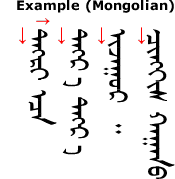
Last week a visitor to Omniglot asked me whether there is a single word in English that means writing direction, i.e. the direction in which writing systems are written. The Latin alphabet, for example, is written from left to right in horizontal lines, as are many other writing systems, while writing systems like Arabic and Hebrew are written from right to left in horizontal lines, and a few writing systems, such as traditional Mongolian and Manchu, are written from top to bottom in vertical columns running from left to right – other directions are available.
On Wikipedia I found the word directionality, and I found that there are more precise words for this concept in German and Dutch: Schreibrichtung / Schriftrichtung and Schrijfrichting. On the W3C site I found the term script direction.
The lack of a single-word term in English is partly because in English noun phrases are usually written as separate words, unlike in German and Dutch, where they are often written as single words.
I came up with some alternative possible terms for this phenomenon: scribeway / scribe way, scribepath / scribe path, script direction, script path, script way, script course, script orientation, or using Greek rather than Latin/Germanic roots: graphodromos, or grammadromos (dromos = road in Greek), or mixing Latin and Greek roots: scriptodromos / grammadromos.
What is writing direction called in other languages? Are there any others which use a single word.
Closest English word I can think of off the top of my head is “boustrophedon” but that only defines writing in a fashion that the reading direction changes from right-to-left to left-to-right every line from Ancient Greek βουστροφηδόν (boustrophēdon) from βοῦς (bous, “ox”) + στροφή (strophē, “turning”)
If you want all English rather than English/Latin/Greek how about ‘writing-run’?
I like Mayan Heiroglyphs best – in twin columns top to bottom but within the columns as follows (assuming 8 lines in each column) – each number is a complete word:
1 2 9 10 17 18
4 3 12 11 20 19
5 6 13 14 and so on – you get the drift!
8 7 16 15
Each word is a spiral (A-H are syllabic glyphs – can I call them letters?):
DC
EABH
FG
And of course each glyph is a monstrous picture in its own right!!!
Finnish has the word “kirjoitussuunta”, literally “writing direction”.
By the way, the stem of the Greek word gramma is grammato-, so you would actually get “grammatodromos”.
Why did he need a single word? For a crossword?
Lev – he didn’t say why he wanted a single word.
English lacks a single word for writing direction in common use because native speakers take the left to right direction for granted. It’s kind of like the saying :the last to discover the water will be the fish.
In the printing industry there’s the term “right-reading” ie. a copy that reads correctly in the language in which it is written. Also describes a photo whose orientation looks like the original scene, as compared to a flopped image (wrong-reading)
Chinese, Japanese, and Korean can all be written either vertically or horizontally: vertically in columns starting at the top right and written top-to-bottom; or horizontally in rows starting at the top left and written left-to-right (Latin fashion) — the characters themselves (which all fit into notional squares) remaining unrotated,
Vertical alignment was the original “default arrangement” in all three languages: it suited writing with a brush in the right hand while gradually unfurling a scroll of paper with the left hand. Nowadays, horizontal alignment has almost entirely replaced vertical in China (since the communist revolution) and (more recently) in Korea too. Vertical alignment remains strong in Japan, however, where most books, newspapers, and magazines are still printed this way (which is why you begin reading a Japanese book at the “back”).
Writing direction in Japanese is literally 書き込み方向 (kakikomi hōkō), but the technical term is 言語の方向性 (gengo no hōkō-sei — lit. “language directionality”).
In referring to boustrophedon the Greek imagery is kept: the Japanese call this 犂耕体 (rikō-tai — lit. “ploughing style”).